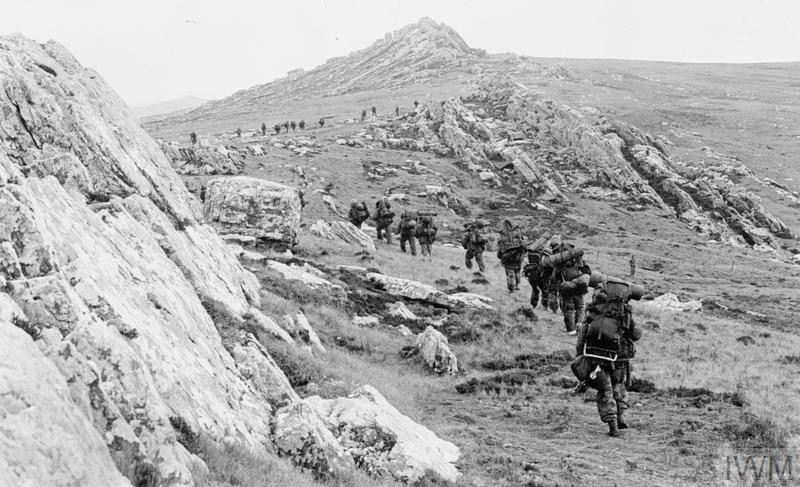Friday 11 June 1982 started off as another quiet day in terms of action, though an early morning bombing raid by Sea Harriers was directed at Stanley airfield to try to discourage any air activity later in the day, while Argentine headquarters buildings were also targeted.
RAF Harrier GR3s were also in action, bombing a number of Argentine positions.
A house on the outskirts of Stanley was hit during shelling, killing two women outright and fatally wounding a third – the only civilian casualties of the conflict.
But as the sun went down, the storm was about to break around the Argentine troops stationed in the high ground near Stanley, the capital of the Falkland Islands.
Stanley is ringed by mountains to the west, overlooking relatively open ground, and with Argentine forces on the peaks and ridges a daylight attack would have been disastrous, so the three-pronged assault was set for the night of 11-12 June.
By evening most of the infantry battalions that would spring forward towards the high ground around Stanley were in place, and their artillery support was also ready to pound the defensive positions that protected the enemy garrison.
Members of 3 Para had been patrolling aggressively to the north-west of Stanley, sometimes skirmishing with Argentine troops, but by mid-evening on 11 June the attack was under way, starting to the east of Murrell Bridge and heading for Mount Longdon.
An unfortunate paratrooper stepped on a mine during the move forward, alerting the Argentinians, many of whom had been asleep but who joined battle in the dark.
It was a hard slog for the Paras, who also had the support of Type 21 frigate HMS Avenger’s 4.5in gun, and their objective would not be achieved until dawn on 12 June.
Further south, Royal Marines of 45 Cdo had also been probing the Argentine line, advancing as far as Two Sisters Mountain, which lies directly west of Stanley.
On the evening of 11 June, as 3 Para advanced to the north of them, 45 Cdo made a silent move forward from Mount Kent.
Once the attack was under way, heavy resistance was met, and once again a long night’s fighting lay ahead of the bootnecks, though they also benefited from naval gunfire support, in this case the 4.5in guns of County-class destroyer HMS Glamorgan.
The third battle of 11-12 June was for Mount Harriet, which lies south-east of Two Sisters, and this engagement was undertaken by 42 Cdo, who had been based around Mount Challenger for a week.
This was the only attack that was preceded by an artillery bombardment, and started slightly later than those to the north; the advancing Marines also encountered stiff resistance, as well as accurate artillery shells from batteries of 105mm guns, though by the time they achieved their objective on the morning of Saturday 12 June they had suffered remarkably few casualties.
Nearly 8m000 miles to the north there was an altogether different mood on Southampton Water as the ocean liner-turned-troopship QE2 returned to her home port, carrying around 700 survivors from HM Ships Ardent, Antelope and Coventry.
Supply ship RFA Fort Austin was also heading home, sailing from South Georgia on 11 June, while ammunition, explosives and stores ship RFA Regent arrived in Cumberland East Bay, South Georgia, on the same day.
Today’s image from the Imperial War Museum collection (© IWM FKD 165) shows 42 Cdo RM on Mount Harriet.
* These posts can only give a brief sense of what was a complex and fast-moving situation 40 years ago, and cannot cover the involvement of every ship, squadron and unit in detail – for a much more comprehensive account see the Falklands section of naval-history.net at https://www.naval-history.net/NAVAL1982FALKLANDS.htm
